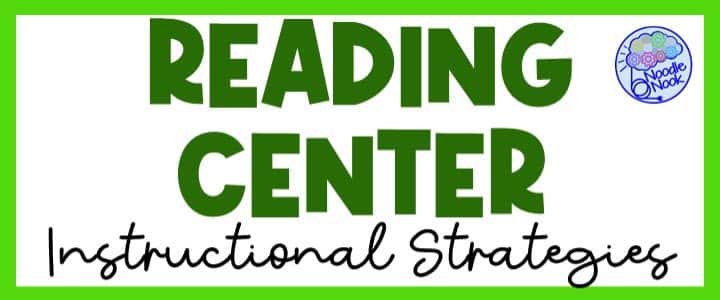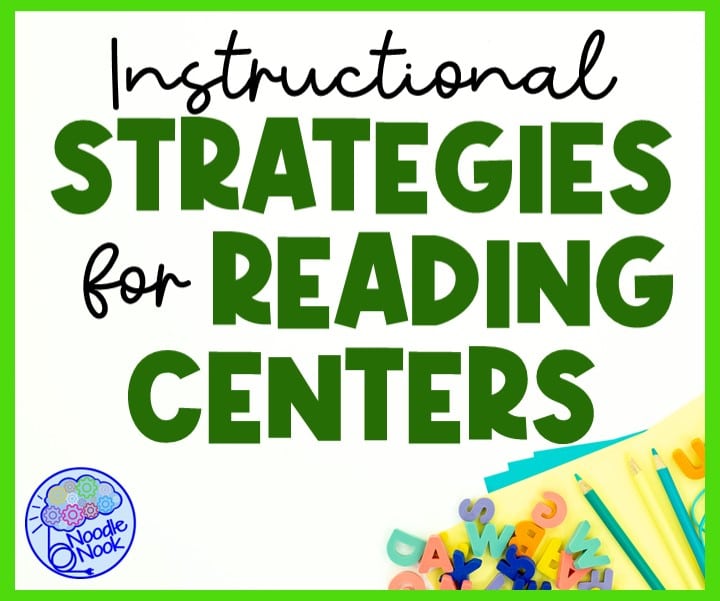As a general education teacher working with students with special needs, it’s important to have a toolkit of instructional strategies for reading centers at your disposal. The following list includes a variety of activities and techniques that can be effective for helping students with special needs make progress and achieve success during reading centers.
5 Top Instructional Strategies
Here are a few instructional strategies for reading centers that can be helpful.
Differentiated Instruction
Tailoring your instruction to meet the unique needs and abilities of each student during reading centers means using different materials or techniques for different students, or modifying your teaching style to better match the learning styles of your students.
Try
- Providing leveled reading materials or texts with modified language and vocabulary for students with language delays or learning disabilities
- Using visual or auditory prompts to support students with attention or memory difficulties
- Offering a choice of reading materials or activities to allow students to choose what interests them and what is most developmentally appropriate for them
Visual Supports
Using visual aids, like pictures, charts, and diagrams, can be an effective way to help students with special needs understand and retain new information during reading centers.
Try
- Using visual organizers, such as concept maps or graphic organizers, to help students understand and analyze the content of a text
- Displaying pictures or images related to the text to help students make connections and build background knowledge
- Providing visual prompts or prompts with pictures to help students remember steps or procedures
Multisensory Instruction
Engaging multiple senses (such as sight, sound, and touch) can be an effective way to help students with special needs learn and retain new information during reading centers. This might involve using hands-on materials, music, or other multimedia resources.
Try
- Using hands-on materials, such as letter tiles or manipulatives, to help students learn phonics or other reading skills
- Using music, rhymes, or other auditory supports to engage students and reinforce learning
- Using tactile or kinesthetic activities, such as acting out a story or creating a craft, to engage students and reinforce learning
Structured Routines
Establishing clear routines and procedures can help students with special needs feel more secure and better able to focus on learning during reading centers.
Try:
- Providing clear and concise instructions for each activity, including any necessary materials and the steps involved
- Using a visual schedule or sequence of events to help students understand and anticipate what will happen next
Collaborative Learning
Working in small groups or pairs can be an effective way for students with special needs to learn from and support each other during reading centers.
Try:
- Pairing students with different abilities or learning styles to support each other during reading centers
- Encouraging students to take turns reading aloud or working on activities together
- Providing structured opportunities for students to share their learning with each other, such as through discussion or presentation
These are just a few ideas of how to use strategies to support students with special needs during reading centers. It’s important to be flexible and responsive to the needs of your students, and to be open to trying new approaches and techniques if something isn’t working. With patience, persistence, and a positive attitude, you can help your students with special needs make progress and achieve success in the classroom.
What Now?
When working with a mixed ability classroom during reading centers, it’s important to structure the centers in a way that meets the needs of all students. One effective approach is to create a tiered system of activities, with different levels of difficulty or complexity for each center. This allows you to differentiate instruction and provide appropriate challenges for each student.
You might also consider grouping students by ability or need, and providing specific supports and accommodations as needed. It’s important to be flexible and responsive to the needs of your students, and to be willing to make adjustments to the structure of the centers as needed.
By providing a range of activities and supports, you can help all of your students make progress and achieve success during reading centers.
Helpful Resources for Reading Centers
There are a wide variety of printable tools and resources that can help teachers support students with special needs in the classroom. Some examples include:
- Visual schedules: These can help students with special needs understand and anticipate what will happen next, and can be especially helpful for students with autism or attention deficits. Check out this one here.
- Visual prompts: These can help students with special needs remember steps or procedures, and can be used for a wide range of activities, such as following a recipe or completing a task.
- Graphic organizers: These can help students with special needs organize and analyze information, and can be used for a wide range of activities, such as summarizing a text or brainstorming ideas. Check out this set here.
- Picture cards: These can be used to support communication, vocabulary development, and other language skills for students with special needs. Here is a simple set to get started.
- Adapted books: These are modified versions of traditional books that have been simplified or modified to make them more accessible for students with special needs. Check out this collection.
- Visual supports for behavior management: These can help students with special needs understand and regulate their own behavior, and might include visual prompts or charts to track progress. Check out this great toolkit.
- Social skills worksheets: These can be used to support the development of social skills and communication skills for students with special needs. Check out this bundle for social justice.
- Reading comprehension worksheets: These can be used to support reading fluency and understanding for students with special needs.
It is especially important for teachers working with students with special needs to use the right materials and resources in order to support their learning and development. These students have the capacity to learn and grow, just like any other student, but they may require different or additional supports in order to access the curriculum and make progress.
By carefully selecting materials and resources that are appropriate for the needs and abilities of these students, teachers can create an inclusive and supportive learning environment that helps all students succeed.


